I had a completely different post planned and tossed it out the window this morning over my coffee as I watched the birds out my window. I have an especially interesting bird in my hipster Minneapolis neighborhood, a Cooper’s Hawk. A Cooper’s hawk in and of itself may not be the most exciting bird on the planet as it is a very common urban hawk, but this particular bird offers a mystery for me to chew on.
Yesterday while catching up on work after an amazing vacation at the Rio Grande Valley Bird Festival, I heard my local American Crows going bonkers. I looked out the window and found the above hatch year Cooper’s Hawk chowing down on a pigeon in the alley. I set up my spotting scope on the raptor and noted with delight that the bird was banded. I knew it was a long shot with the storm windows in place to get a clear photo of the band numbers, but I tried to digiscope it anyway. I didn’t want risk opening the storm window and startling the bird off of its meal. It’s hard enough to navigate your first year of survival as an accipiter, I felt the bird’s refueling trumped my need to know the band number.
I was intrigued by who could have placed that band on the hawk. I know who the bird banders are in the Twin Cities metro area–no one is banding Cooper’s hawks. However, about 150 miles north of my home is Duluth, MN where I know a few hawk banders including the folks at Hawk Ridge, Frank Taylor and Frank Nicolletti (aka hawk counter extraordinaire) band hawks in the fall. I think chances are good that this bird was banded in Duluth which led me to rethink my winter Cooper’s hawk observations. They are very common in my neighborhood and I have always assumed the brown hatch year birds I see in the winter are resident birds hatched in my ‘hood. This banded Cooper’s would suggest otherwise.
I posted a photo of the hawk with the band on Facebook and tagged all of the Minnesota hawk banders I know. Surprisingly, Frank Taylor said that he did not get a hatch year Cooper’s hawk at his banding station this season, so we know the bird wasn’t banded by him…interesting.
The hawk ate some of the pigeon and then flew up with the remainder to a high branch to finish its meal in a less vulnerable area. I noted with delight that the feathers and bones landed on the stoop of a rather noisy neighbor and mentally thanked the hawk for leaving a bloody, feathery mess and a large fecal deposit for them. Heh.
This morning, I heard the crows harassing something again. I sipped my shade-grown coffee and watched as six crows lined up and surrounded the above grey squirrel who was eating some chicken it discovered in our dumpster. The crows were inching closer and periodically displaced when the squirrel would charge them. I watched this routine three times when all of a sudden: BAM! The Cooper’s Hawk flew into the middle of the scene, sending squirrel and chicken straight up the trunk like a rocket and scattering crows like spilled marbles. The raptor didn’t appear to have a serious hunting plan. Accipiters like Cooper’s hawks tend to act before they think, they are very reactive to movement and I’m certain the crow/squirrel game had the bird’s attention.
She landed about twenty feet from my window and I set up my scope. I love this look on her face! Her eyes followed the crows as they bounced around the branches surrounding her. It’s that excited hawk look that seems to say, “Wow! Can I eat that?”
She was so focused on the crows, that I was able to get the storm window open to try for a better photo without scaring her off. Of course, as soon as I got the scope on her, she tucked her banded foot up into her feathers (which generally means the bird is relaxed and I usually take it as a compliment from birds–I’m not disturbing them). But that meant there was no way to get read on her band numbers. The photos probably would have been just as unreadable, the heat from my apartment was escaping out of my window and made for some wicked heat shimmer and impossible focusing conditions!
It was interesting to note that the crows were not on full alarm with the hawk. Their calls the day before were much more agitated, but that could have been because of the dead pigeon. They certainly did not mob this hawk as hard as they do when a larger hawk or owl is in the neighborhood. Even when the Cooper’s would chase one of the crows, they seemed to know that it wasn’t a serious chase, or at least there was no way that hawk would be able to catch them. Some crows continued to forage the dumpsters while a small group remained in the trees and kept an eye on the hawk.
I’ll be curious to see how long this hawk hangs out in my neighborhood. I’ve put extra feed in my bird feeders to attract potential food for her. I even scattered extra seed on the ground and ledge to get the pigeons’ attention. We’ll see if we can’t get a read on her band numbers yet.
It just goes to show that even a common yard bird can offer a new perspective when birding at home.


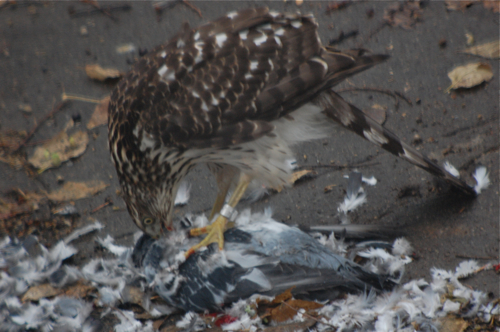
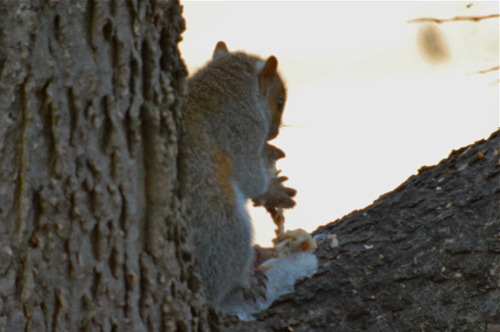
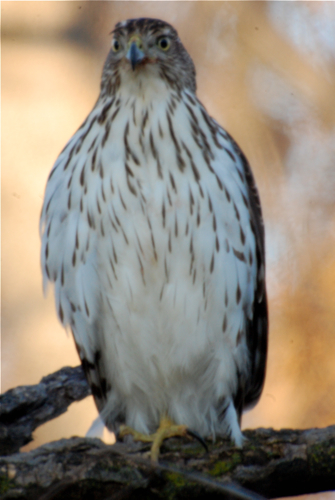
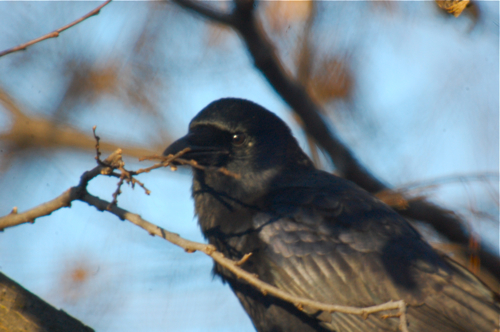





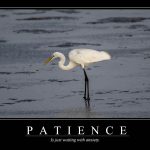
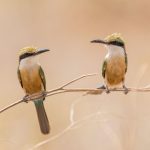

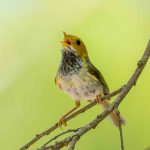


Sharon,
Many thanks for that piece on Coopers hawks. I’ve never seen such an abundance of them out here in the country west of St. Louis and In St. Louis itself. We watched one in Kirkwood carry a gray squirrel to a tree and devour it, leaving only the fur coat hanging on a branch. There, and out here in Franklin County, they monitor the feeders from dawn to dusk and take more than a few songbirds. They seem to be getting bolder and bolder, as well. I went out on my deck and one that had been perched on the ash tree there flew a mere twenty yards away and sat calmly in an oak watching me. Interestingly, however, when I go outside, the birds immediately return to the feeders.
Thanks again.
Pete Connolly
Great post, Sharon. I guess this will be a lesson to you to quit heating your apartment to avoid those nasty heat shimmers!
Nice post, I love any raptor. This Cooper´s Hawk will hopefully give you more shows and shots. Keep us posted..
P.S Check out this raptor center in Ecuador.. http://www.pululahuahostal.com/html/condor_park.html
Hi, Sharon. Thanks for sharing the pics and thoughts. I too live in So. Mpls (near the Riverview Theater) and saw a mother Cooper’s hawk and her two juveniles earlier this fall. One day I saw this trio twice as I walked toward the river. The first time the two juveniles were very playful, swooping back and forth toward each other while Mom watched from a tree. Later, I saw them all in hunting stance, perched on adjoining trees along the Winchell trail (near the River.) Didn’t see them catch anything though.
A couple of years ago I saw a Cooper’s hawk snatch a baby robin from a nest near Lake Harriet. It was one of the most emotional bird watching moments I can remember. The mother robing was dive bombing the nest to try and move the Cooper’s Hawk away. The Cooper’s Hawk took the baby, landed across the street on the grass with it and kneaded its claws into it to kill it, mother robing still swooping by. Then the Cooper flew off with its prey to eat it elsewhere. I was transfixed by the whole event. My then 9-year old son started crying. Sheesh. Lesson on the circle of life.
Thanks again for the nice posts!
Great to see banded hawks! I am originally from Duluth, MN and Hawk Ridge is one of my favorite birding spots in the world. It’s good to know that the invasive species are able to provide food for others!
Cathy, I think I might have cried too. What a story!
Thanks for the notes everyone! I got an email from a bander who use to live here and he said that Dave Evans at Hawk Ridge always adds a crimp mark to the band which might be easier to find rather than trying to get the entire numerical code. I’m going to watch for that should she come back.
@Cathy I think I’ve seen that same hawk family when biking around Lake Harriet (I live around the Uptown Area). I’ve had that same pang when watching the crows raid the local pigeon nests for squab. Cooper’s hawk and crow are two ways that I would not want to die.
@Renato Thanks for the Ecuador link!
Hi. My name is Leslie. I live in Lauderdale, MN and my backlot has large deciduous and pine trees with many native plants growing underneath them. In mid May I observed a pair of hawks building a large nest in the upper part of a giant Maple Tree in my backyard. It was a fascinating process to observe. Now, every morning, I sip my coffee in the backyard and my Belgian Shepard & I listen to the calls of young birds in the nest while watching the aerial expertise of their parents flying in and out of branches. It’s sort of like watching a Raptor Version of Circus Juenventes. Originally, I was thinking that we have been observing Sharp Shinned Hawks… but I am fairly certain (after doing research) that we are sharing our backyard with a pair of Cooper’s Hawks. The pair don’t seem to be interested in the lovely cardinals that live in my back yard. (Although, the cardinals seem to be roosting in smaller bushes in my yard and avoiding the big trees they used to hang out in. My neighbor down the alley raises chickens and I am thinking this is a prime food source for our raptors.
Just a quick look at the birdfeeders this AM in my WI woodlot when a hawk was after something on the ground. Didn’t get it but it flew up on a branch about 20 feet high. The object of this 2nd year female cooper’s was a red squirrel. The squirrel then preceded to pester the bird, twice by coming out on the same branch to within 15 inches all the while flapping his tail. The hawk tried again to catch the quick little squirrel but to no avail. The Juno’s, chickadee’s, woodpeckers were sitting immobile in the trees and shrubs.